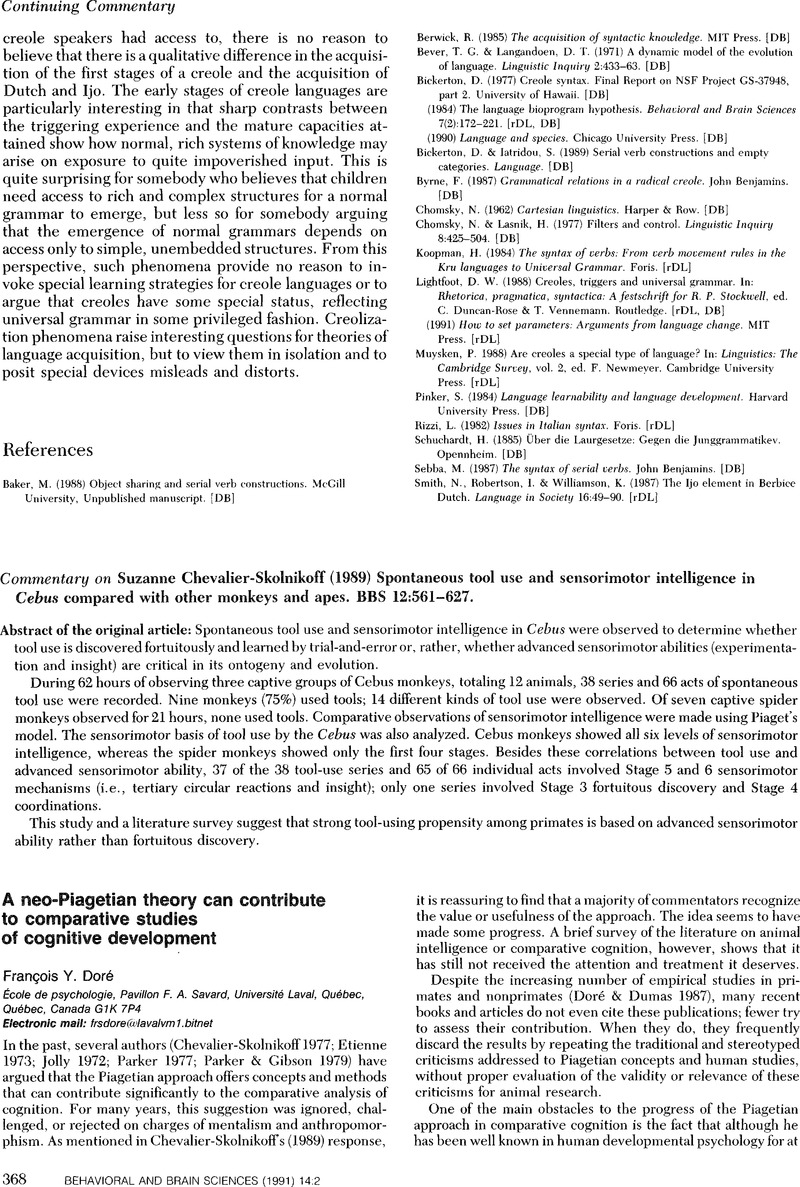No CrossRef data available.
Article contents
Procedures and chronology
Published online by Cambridge University Press: 19 May 2011
Abstract
An abstract is not available for this content so a preview has been provided. Please use the Get access link above for information on how to access this content.

- Type
- Author's Response
- Information
- Copyright
- Copyright © Cambridge University Press 1991
References
Altmann, J. (1974) Observational study of behavior: Sampling methods. Behaviour 49:227–67. [STP]CrossRefGoogle ScholarPubMed
Beck, B. (1972) Tool use in captive hamadryas baboons. Primates 13:276–96. [rSC–S]CrossRefGoogle Scholar
Beck, B. (1973) Observational learning of tool use by captive Guinea baboons (Papio papio). American Journal of Physical Anthropology 38(2):579–82. [rSC–S]CrossRefGoogle Scholar
Beck, B. (1976) Tool use by captive pigtailed macaques. Primates 17(3):301–10. [rSC–S]CrossRefGoogle Scholar
Chevalier-Skolnikoff, S. (1971) Ontogeny of communication in Macaca speciosa. Ph. D. dissertation, Department of Anthropology, University of California, Berkeley. [STP]Google Scholar
Chevalier-Skolnikoff, S. (1973) Facial expression of emotion in nonhuman primates. In: Darwin and facial expression, ed. Ekman, Paul. Academic Press. [STP]Google Scholar
Chevalier-Skolnikoff, S. (1974) Ontogeny of communication in the Stumptail Macaque (Macaca arctoides). Karger. [STP]Google Scholar
Chevalier-Skolnikoff, S. (1975) A proposed model for the analysis of primate “protoculture” in terms of intellectual abilities. Paper presented at the 74th Annual Meeting of the American Anthropological Association, San Francisco. [rSC–S]Google Scholar
Chevalier-Skolnikoff, S. (1976a) The ontogeny of primate intelligence and its implications for communicative potential: A preliminary report. Origins and evolution of language and speech. Annals of the N.Y. Academy of Sciences, Vol. 280, ed. Hamad, S., Steklis, D. & Lancaster, J.. [STP]CrossRefGoogle Scholar
Chevalier-Skolnikoff, S. (1976b) Intelligence of wild Cebus monkeys and implications for evolution of tool use. Wenner-Gren Grant No. 3116, awarded January 15, 1976. [STP]Google Scholar
Chevalier-Skolnikoff, S. (1977) A Piagetian model for describing and comparing socialization in monkey, ape, and human infants. In: Primate biosocial development: Biological, social, and ecological determinants, ed. Chevalier-Skolnikoff, S. & Poirier, F. E.. Garland Publishers. [FYD, STP]Google Scholar
Chevalier-Skolnikoff, S. (1979) Kids: Zoo research reveals remarkable similarities in the development of human and orangutan babies … and one very special difference. Animal Kingdom 82(3):11–18. [rSC–S]Google Scholar
Chevalier-Skolnikoff, S. (1982) A cognitive analysis of facial behavior in Old World monkeys, apes, and human beings. In: Primate communication, ed. Snowdon, C. T., Brown, C. H. & Petersen, M. R.. Cambridge University Press. [rSC–S]Google Scholar
Chevalier-Skolnikoff, S. (1983) Sensorimotor development in Orang-utans and other primates. Journal of Human Evolution 12:545–61. [rSC–S, STP]CrossRefGoogle Scholar
Chevalier-Skolnikoff, S. (1990) Tool use by wild Cebus monkeys at Santa Rosa National Park, Costa Rica. Primates 31(3):375–83. [rSC–S]CrossRefGoogle Scholar
Chevalier-Skolnikoff, S. & Parker, S. T. (1975) The development of intelligence and communication in great apes in terms of Piaget's model of human infant development. Grant No. 2-50-6905-36523-3. Hooper Foundation, University of California, San Francisco. [STP]Google Scholar
Chevalier-Skolnikoff, S., Galdikas, B. M. F. & Skolnikoff, A. Z. (1982) The adaptive significance of higher intelligence in wild orangutans: A preliminary report. Journal of Human Evolution 12:545–63. [rSC–S]CrossRefGoogle Scholar
Dorè, F. Y. & Dumas, C. (1987) Psychology of animal cognition: Piagetian studies. Psychological Bidletin 102:219–33. [FYD]Google Scholar
Dumas, C. & Doré, F. Y. (1989) Cognitive development in kittens (Felis catus): A cross-sectional study of object permanence. Journal of Comparative Psychology 103:191–200. [FYD]CrossRefGoogle Scholar
Etienne, A. S. (1973) Developmental stages and cognitive structures as determinants of what is learned. In: Constraints on learning. Limitations and predispositions, ed. Hinde, R. A. & Stevenson-Hinde, J.. Academic Press. [FYD]Google Scholar
Gibson, K. R. & Parker, S. T. (1975) Sensorimotor intelligence in relation to feeding strategies in wild Cebus monkeys (Cebus capucinus imitator) in Costa Rica. Research Proposal submitted to the National Science Foundation, Anthropology Program, Division of Social Sciences, December 2. [STP]Google Scholar
Harris, P. L. (1983) Infant cognition. In: Handbook of child psychology, 4th ed., Vol. 2: Infancy and developmental psychobiology, ed. Haith, M. M. & Campos, J. J.. Wiley. [FYD]Google Scholar
Mathieu, M., Bouchard, M. A., Granger, L. & Herscovitch, J. (1976) Piagetian object-permanence in Cebus capucinus, Lagothrica flavicauda and Pan troglodytes. Animal Behaviour 24:585–88. [FYD]CrossRefGoogle Scholar
Parker, S. T. (1973) Piaget's sensorimotor series in an infant macaque: The organization of nonstereotyped behavior in the evolution of intelligence. Ph.D. Dissertation, Department of Anthropology, University of California, Berkeley. [STP]Google Scholar
Chevalier-Skolnikoff, S. (1976) A comparative longitudinal study of sensorimotor development in a macaque, a gorilla, and a human infant from a Piagetian perspective. Paper presented at the Animal Behavior Society Meetings. Boulder, CO [STP]Google Scholar
Chevalier-Skolnikoff, S. (1977a) Comparative behavioral development in human, gorilla, and macaque infants. Paper presented at the 46th Annual Meeting of the American Association of Physical Anthropologists. Seattle. [STP]Google Scholar
Chevalier-Skolnikoff, S. (1977b) Piaget's sensorimotor series in an infant macaque: A model for comparing unstereotyped behavior and intelligence in human and nonhuman primates. In: Primate Bio-Social Development: Biological, social, and ecological determinants, ed. Chevalier-Skolnikoff, S. & Poirier, F. E.. Garland Publishers. [FYD, STP]Google Scholar
Chevalier-Skolnikoff, S. (1983) Intelligent locomotion? Leaping to conclusions about orang-utan intelligence. Letter to the Editor. Journal of Human Evolution 12:495–97. [STP]Google Scholar
Chevalier-Skolnikoff, S. (1989) The development of object-oriented vs. social intelligence in a gorilla and a human infant. Paper given at the American Society of Primatologists, Mobile, Ala. [STP]Google Scholar
Parker, S. T. & Gibson, K. R. (1977) Object manipulation, tool use, and sensorimotor intelligence as feeding adaptations in Cebus monkeys and great apes. Journal of Human Evolution 6:623–41. [STP]CrossRefGoogle Scholar
Parker, S. T. & Gibson, K. R. (1979) A developmental model for the evolution of language and intelligence in early hominids. Behavioral and Brain Sciences 2:367–408. [FYD]CrossRefGoogle Scholar
Piaget, J. (1952) The origins of intelligence in children. International Universities Press. [FYD]CrossRefGoogle Scholar


